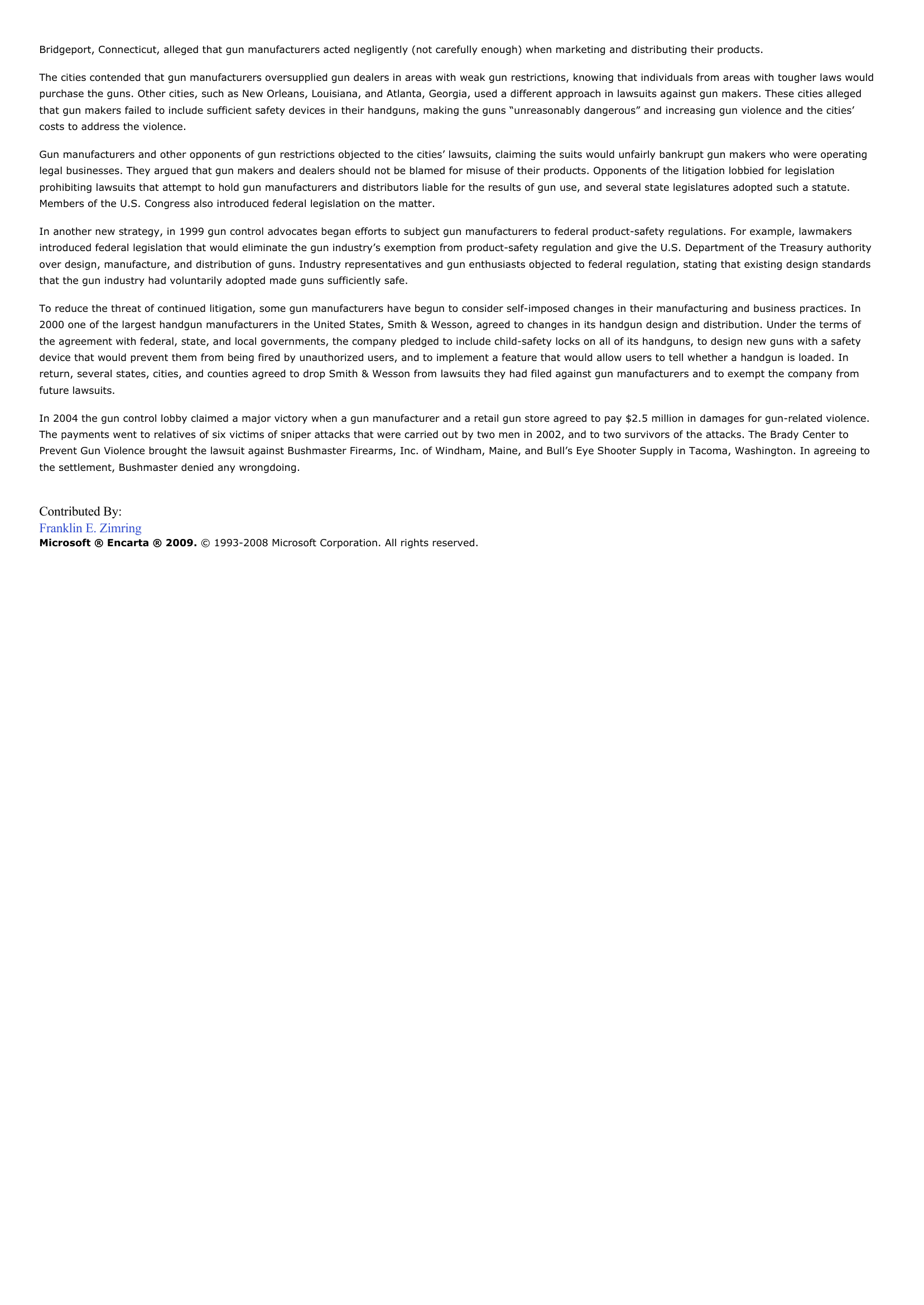Gun Control.
Publié le 10/05/2013

Extrait du document
«
Bridgeport, Connecticut, alleged that gun manufacturers acted negligently (not carefully enough) when marketing and distributing their products.
The cities contended that gun manufacturers oversupplied gun dealers in areas with weak gun restrictions, knowing that individuals from areas with tougher laws wouldpurchase the guns.
Other cities, such as New Orleans, Louisiana, and Atlanta, Georgia, used a different approach in lawsuits against gun makers.
These cities allegedthat gun makers failed to include sufficient safety devices in their handguns, making the guns “unreasonably dangerous” and increasing gun violence and the cities’costs to address the violence.
Gun manufacturers and other opponents of gun restrictions objected to the cities’ lawsuits, claiming the suits would unfairly bankrupt gun makers who were operatinglegal businesses.
They argued that gun makers and dealers should not be blamed for misuse of their products.
Opponents of the litigation lobbied for legislationprohibiting lawsuits that attempt to hold gun manufacturers and distributors liable for the results of gun use, and several state legislatures adopted such a statute.Members of the U.S.
Congress also introduced federal legislation on the matter.
In another new strategy, in 1999 gun control advocates began efforts to subject gun manufacturers to federal product-safety regulations.
For example, lawmakersintroduced federal legislation that would eliminate the gun industry’s exemption from product-safety regulation and give the U.S.
Department of the Treasury authorityover design, manufacture, and distribution of guns.
Industry representatives and gun enthusiasts objected to federal regulation, stating that existing design standardsthat the gun industry had voluntarily adopted made guns sufficiently safe.
To reduce the threat of continued litigation, some gun manufacturers have begun to consider self-imposed changes in their manufacturing and business practices.
In2000 one of the largest handgun manufacturers in the United States, Smith & Wesson, agreed to changes in its handgun design and distribution.
Under the terms ofthe agreement with federal, state, and local governments, the company pledged to include child-safety locks on all of its handguns, to design new guns with a safetydevice that would prevent them from being fired by unauthorized users, and to implement a feature that would allow users to tell whether a handgun is loaded.
Inreturn, several states, cities, and counties agreed to drop Smith & Wesson from lawsuits they had filed against gun manufacturers and to exempt the company fromfuture lawsuits.
In 2004 the gun control lobby claimed a major victory when a gun manufacturer and a retail gun store agreed to pay $2.5 million in damages for gun-related violence.The payments went to relatives of six victims of sniper attacks that were carried out by two men in 2002, and to two survivors of the attacks.
The Brady Center toPrevent Gun Violence brought the lawsuit against Bushmaster Firearms, Inc.
of Windham, Maine, and Bull’s Eye Shooter Supply in Tacoma, Washington.
In agreeing tothe settlement, Bushmaster denied any wrongdoing.
Contributed By:Franklin E.
ZimringMicrosoft ® Encarta ® 2009. © 1993-2008 Microsoft Corporation.
All rights reserved..
»
↓↓↓ APERÇU DU DOCUMENT ↓↓↓
Liens utiles
- Anglais Gun control
- Gun Control
- sh?gun.
- Medidas de control de inundaciones - geografía.
- Canada's Constitution Act of 1982 In 1982 the Canadian constitution was patriated, meaning it was brought further under Canadian control.




















